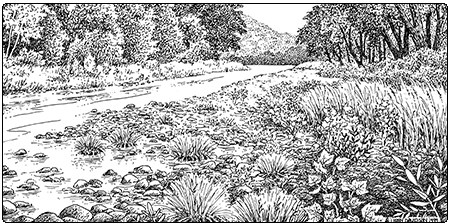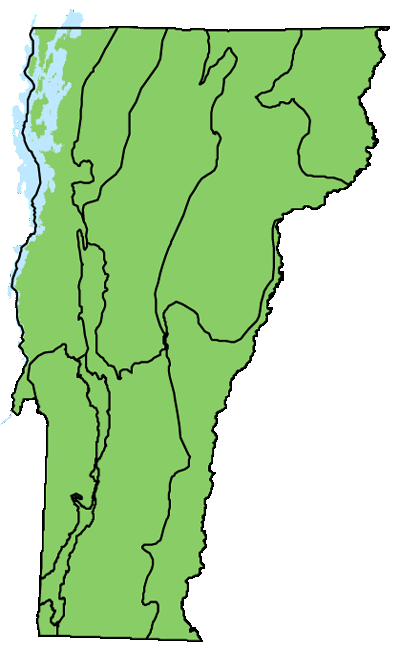Ecology and Physical Setting 
Flowing rivers possess and release incredible amounts of energy. River Cobble Shores, among Vermont’s most dynamic natural communities, are products of this energy. You can actually see and hear them being formed and altered. Standing in a safe location next to one of our high-gradient, high-energy rivers like the White or the West during a flood, you can hear large cobbles and boulders clunking and tumbling down the river. When the flood waters recede, you will see a new or altered cobble bar.
Cobble shores are often best developed on the inside of river bends and at the upstream end of river islands. They can also occur at the mouths of tributary streams. In these places, flood waters slow down and cobbles are deposited.

In addition to flooding and the shifting of substrate during high water conditions, River Cobble Shores are also kept open by ice scour. Gravel, sand, silt, and even fine organic material all accumulate in the spaces between the cobbles, and on the more stable cobble shores, these materials form a moist environment where plants become established. As high-energy rivers migrate across their floodplains, River Cobble Shores may be eroded away, or they may continue to accumulate sediments and eventually develop into floodplain forests.
River Cobble Shores grade into Rivershore Grasslands, which occur landward in the river channel.
Vegetation
River Cobble Shores are sparsely vegetated, but the pattern of vegetation typically varies with the distance from the summer low water levels. The portions of cobble shores closest to the lowest water levels are most disturbed by frequent flooding and shifting substrate. Vegetation is sparse in these areas. In contrast, the higher portions of cobble shores are less frequently flooded and more stable, and they accumulate fine materials. These areas have more herbaceous and woody species. Vegetation patterns in this community are also greatly affected by the shifting of river channels over time.
Although River Cobble Shores are sparsely vegetated, the number of species tends to be relatively high. Twisted sedge is typical. This tenaciously rooted sedge has a densely cespitose (clumped) growth form, and its small seeds are water dispersed in inflated perigynia. These characteristics are excellent adaptations for the fast-water shore environment in which it is found.

flooding and ice scour.
Other common species include Indian hemp, big bluestem, little bluestem, grass-leaved goldenrod, Joe-pye weed, dock-leaved smartweed, and bluejoint grass. Typical shrubs include silky willow and woolly-headed willow. Saplings of cottonwood and sycamore may be common at some sites. Sycamore—which needs bare soil to germinate and abundant light to survive as a seedling—is especially well suited for colonization of cobble shores and can tolerate extensive scouring from moving rock and ice. Bryophytes, including species of the moss genus Bryum, may be found in the spaces between cobbles. Non-native, invasive species are abundant on some shores. Japanese knotweed is widespread on River Cobble Shores, displacing native plants and degrading wildlife habitat.
Wildlife Habitat
Raccoons may be common on these shorelines, prowling for crayfish, mussels, and other small animals at the water’s edge. Mink may pass through cobble shores while hunting—equally at home on land and in the water. Spotted sandpipers both forage for invertebrates and build their nests on River Cobble Shores. Dusted skippers may be found where big bluestem and little bluestem are abundant, as these grasses are the host plants for the larvae of this rare butterfly.
River Cobble Shores are prime habitat for two rare tiger beetles—the boulder-beach tiger beetle and the cobblestone tiger beetle. Female tiger beetles lay eggs in burrows excavated in moist substrates. The eggs hatch in mid-summer. The larvae live in small holes in the sand and gravel, waiting to ambush small insects, which they capture with their strong mandibles. After overwintering in the shoreline substrate, the larvae pupate into the more recognizable adult beetles.
Related Communities
- River Sand or Gravel Shores occur on lower gradient reaches of streams and rivers. They are drier than River Cobble Shores because they do not accumulate very fine sediments and organic matter. They are often more sparsely vegetated.
- Rivershore Grassland occurs at higher elevations within the channel than the River Cobble Shore. The substrate is more stable and more densely vegetated with grasses and herbs.
Conservation Status and Management Considerations
As with other natural communities associated with rivers, the condition of River Cobble Shores is inseparable from the condition of the river. A healthy river is free flowing, meanders across its valley, has access to its floodplain, and is bordered by a naturally vegetated riparian area. Long-term conservation of these communities must include watershed-scale planning, as well as consideration of the dynamic nature of rivers. Power generation and flood control dams both alter natural river flows. Run-of-river flows, or mitigation releases, can help maintain natural sediment transport and river dynamics. Non-native, invasive plants are a significant threat to rivershore communities with abundant exposed substrate. Japanese knotweed dominates some rivershore communities, and its control requires concentrated effort.
Distribution/Abundance 
River Cobble Shores occur on high-energy rivers throughout Vermont and eastern North America.
Characteristic Plants
Shrubs
Abundant Species
Silky willow – Salix sericea
Woolly-headed willow – Salix eriocephala
Occasional to Locally Abundant Species
Cottonwood – Populus deltoides
Sycamore – Platanus occidentalis
Herbs
Abundant Species
Twisted sedge – Carex torta
Indian hemp – Apocynum cannabinum
Occasional to Locally Abundant Species
Grass-leaved goldenrod – Euthamia graminifolia
Joe-pye weed – Eutrochium maculatum
Dock-leaved smartweed – Persicaria lapathifolia
Bluejoint grass – Calamagrostis canadensis
Big bluestem – Andropogon gerardii
Little bluestem – Schizachyrium scoparium
Blue vervain – Verbena hastata
Straw-colored flatsedge – Cyperus strigosus
Monkey flower – Mimulus ringens
Nodding beggar’s-ticks – Bidens cernua
Tall meadow rue – Thalictrum pubescens
Virgin’s bower – Clematis virginiana
Evening primrose – Oenothera biennis
Riverbank wild rye – Elymus riparius
Frondose muhlenbergia – Muhlenbergia frondosa
Lady’s thumb – Persicaria maculosa
Non-Native Invasive Plants
Japanese knotweed – Fallopia japonica
Coltsfoot – Tussilago farfara
Common barnyard grass – Echinochloa crus-galli
Reed canary grass – Phalaris arundinacea
White sweet clover – Melilotus albus
Rare and Uncommon Plants
Tubercled orchis – Platanthera flava
Obedience – Physostegia virginiana
Sand cherry – Prunus pumila
Lakeshore sedge – Carex lenticularis
Canada burnet – Sanguisorba canadensis
Whorled milkwort – Polygala verticillata
Woodland rush – Juncus subcaudatus
Redtop panic grass – Coleataenia rigidula
Indian grass – Sorghastrum nutans
Associated Animals
Snapping turtle – Chelydra serpentina
Painted turtle – Chrysemys picta
Raccoon – Procyon lotor
Mink – Neovison vison
Spotted sandpiper – Actitis macularius
Rare and Uncommon Animals
Dusted skipper – Atrytonopsis hianna
Boulder-beach tiger beetle – Cicindela ancocisconensis
Cobblestone tiger beetle – Cicindela marginipennis
Places to Visit
Winooski River at Preston Brook, Camel’s Hump State Park, Bolton, Vermont Department of Forests, Parks, and Recreation (VDFPR)
Hartland Rivershore Natural Area, Hartland, The Nature Conservancy
White River Streambank, Stockbridge, Vermont Fish and Wildlife Department
West River, Townshend, U.S. Army Corps of Engineers
West River, Jamaica State Park, Jamaica, VDFPR
